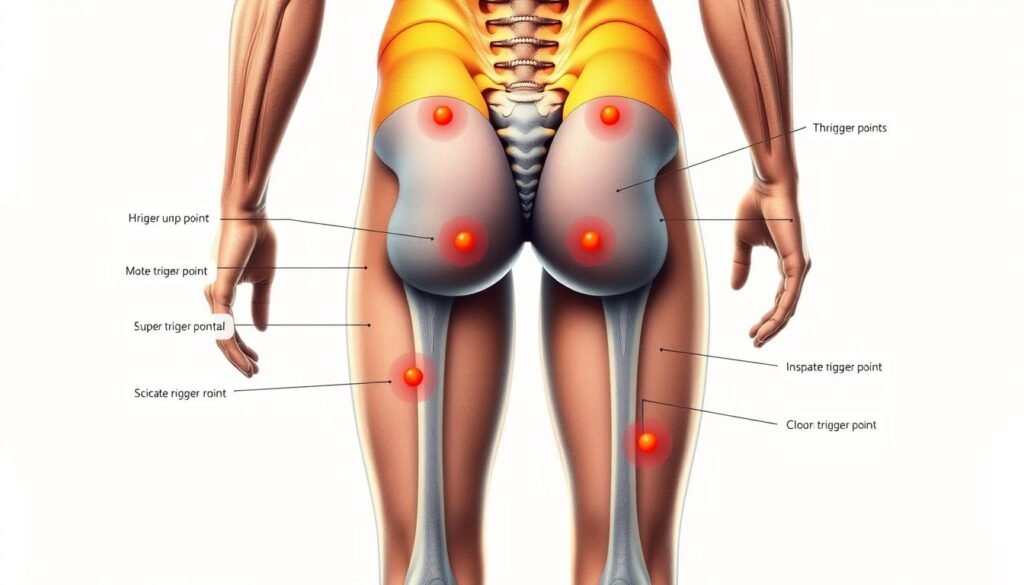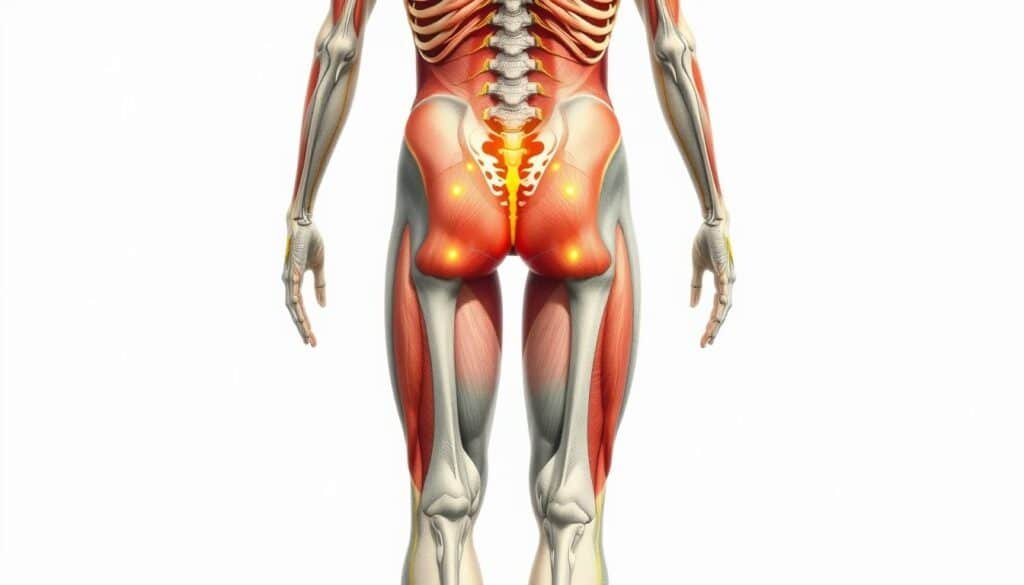Have you ever felt a sharp, shooting pain from your lower back down to your leg? You’re not alone. Sciatica affects millions, but could the solution be at your fingertips?
I’ve explored the world of sciatica pain relief, and I’m excited to share my findings. Trigger point therapy and sciatic nerve massage techniques offer promising results for those seeking respite from this debilitating condition.
In this guide, I’ll walk you through effective massage methods to target those pesky trigger points and ease sciatic nerve pain. Whether you’re looking for self-care options or professional treatments, we’ll cover it all.
Key Takeaways
- Sciatica affects up to 40% of people in their lifetime
- Massage can effectively reduce pressure on the sciatic nerve
- Trigger point therapy is a key technique for sciatica relief
- Self-massage methods can be done at home for ongoing care
- Professional help may be necessary for severe cases
Understanding Sciatica and Its Causes
Sciatica is a common condition that affects millions of people. It’s important to understand what causes this painful issue and how to recognize its symptoms. Let’s explore the sciatic nerve, common sciatica causes, and typical symptoms.
The Sciatic Nerve
The sciatic nerve is the largest nerve in our body. It starts in the lower back and runs through the buttocks and down each leg. This nerve plays a crucial role in sending signals between our brain and lower body parts.
Common Sciatica Causes
Several factors can lead to sciatica. A herniated disc is often the culprit, putting pressure on the nerve. Spinal stenosis, which narrows the spinal canal, can also cause sciatica. Another frequent cause is piriformis syndrome, where a small muscle in the buttocks irritates the sciatic nerve.
Sciatica Symptoms
Recognizing sciatica symptoms is key to getting proper treatment. Pain that radiates from the lower back down the leg is the most common sign. You might also experience numbness, tingling, or weakness along the nerve path. These symptoms usually affect only one side of the body.
- Lower back pain
- Leg pain or discomfort
- Numbness or tingling
- Weakness in the affected leg
If you’re experiencing these symptoms, it’s important to consult a healthcare professional. They can help determine the underlying cause and recommend appropriate treatment options for your sciatica.
The Role of Trigger Points in Sciatica Pain

Sciatica trigger points are key to understanding sciatica pain. These small muscle knots can cause a lot of pain. Knowing how they affect sciatica can help find relief.
Trigger points are small, tight spots in muscles that can cause pain. In sciatica, these knots often form in the piriformis muscle. This muscle is deep in the buttock. When it tightens, it can press on the sciatic nerve, leading to pain, numbness, and tingling.
Myofascial release techniques can help with these trigger points. By applying pressure and stretching, we can release the knots. This reduces pressure on the sciatic nerve and gives immediate relief. It also helps prevent future pain.
- Identify trigger points in the buttocks and lower back
- Apply gentle, sustained pressure to release muscle knots
- Stretch affected muscles to improve flexibility and reduce tension
Regular massage and self-care can greatly reduce sciatica symptoms. By targeting the cause of pain, we can achieve long-term relief. This improves our quality of life.
Benefits of Massage for Sciatica Relief
Massage is a powerful tool for sciatica relief. Regular sessions can greatly help those with sciatic pain. Let’s look at how massage helps with this common issue.
Muscle Relaxation and Tension Release
Tight muscles can cause sciatic pain by pressing on the nerve. Massage relaxes these muscles, easing the nerve’s pressure. I focus on the piriformis and gluteal muscles during sessions.
This relaxation can greatly reduce pain and improve movement.
Improved Circulation and Healing
Massage increases blood flow to the affected areas, aiding in healing. Better circulation brings oxygen and nutrients to damaged tissues. It also removes waste, speeding up recovery and reducing inflammation.
Stress Reduction and Pain Management
Chronic pain can increase stress, creating a cycle. Massage breaks this cycle by releasing endorphins, our natural pain relievers. It also lowers cortisol, helping to relax the body and mind.
Many clients feel more relaxed and better at managing pain after regular massages. By adding these massage benefits to a treatment plan, people with sciatica can see a big improvement in their quality of life. Remember, regular massage is key to getting the most benefits.
How to Massage Sciatica Trigger Points

Massaging sciatica trigger points can help ease pain. I’ll show you how to find key pressure points and use massage to reduce discomfort.
Identifying Key Trigger Points
Sciatica pressure points are usually in the gluteal muscles, piriformis, and lower back. These spots hold tension that causes sciatic nerve pain. To find them, I press gently around the area until I hit tender spots that cause pain.
Proper Massage Techniques
To do trigger point therapy, I use my thumbs or knuckles to press on the spots. I keep the pressure steady for about 90 seconds while breathing deeply. This method helps relax the muscle and eases pain.
Recommended Pressure and Duration
The massage pressure should be firm but not too hard. I start with a moderate pressure and increase it as the muscle relaxes. I see pain decrease after 30 seconds of pressure. I massage for 10-15 minutes, spending 1-2 minutes on each point.
| Massage Technique | Pressure Level | Duration |
|---|---|---|
| Trigger Point Therapy | Firm, not painful | 90 seconds per point |
| Circular Friction | Moderate | 30-60 seconds per area |
| Kneading | Moderate to firm | 2-3 minutes per muscle group |
By using these methods, I can target sciatica trigger points effectively. This can lead to significant pain relief through self-massage.
Effective Massage Techniques for Sciatica

Specific massage techniques can greatly help with sciatica pain. Let’s look at some effective methods that target the root of sciatic nerve issues.
Myofascial release is a powerful technique. It focuses on the fascia, the tissue around muscles. By applying gentle pressure, it helps release tension and improve flexibility.
Deep tissue massage is also great for sciatica relief. It works on the deeper muscle and fascia layers. This method breaks up adhesions and knots that may cause nerve compression. It can be intense but very effective in reducing pain and improving mobility.
Trigger point therapy is a precise method. It targets specific points of tension in muscles. By applying pressure to these knots, it helps release tension and alleviate pain along the sciatic nerve pathway.
- Swedish massage: Gentle strokes to improve circulation and reduce overall muscle tension
- Reflexology: Targeting specific points on the feet to relieve sciatic pain
- Hot stone massage: Using heated stones to relax muscles and increase blood flow
Self-massage techniques are good for at-home relief. Using tools like tennis balls or foam rollers, you can target specific areas of tension. These methods help maintain relief between professional massages.
Consistency and proper technique are key to effective sciatica massage. Working with a trained professional is crucial. They can create a personalized treatment plan that meets your specific needs and symptoms.
Self-Massage Tools and Techniques for Home Relief
Self-massage is a great way to treat sciatica at home. I’ve found many tools and methods to help ease sciatic pain. Let’s look at some easy ways to manage pain and help your body heal.
Using Foam Rollers and Tennis Balls
Foam rollers are great for easing sciatica pain. I use them to roll out my IT band and hamstrings. This helps release tension.
Tennis balls are perfect for applying pressure to your glutes and lower back. By lying on a ball and moving gently, you can find and release tight spots.
Massage Guns and Their Benefits
Massage guns are amazing for deep tissue relief. These handheld devices send rapid pulses to your muscles. This increases blood flow and reduces pain.
I use mine on my lower back and legs for quick relief. It’s very effective.
DIY Massage Techniques
Simple self-massage techniques can be done anytime. I often use my knuckles to apply pressure along my sciatic nerve. This helps relax tense muscles.
Gentle circular motions on your lower back and buttocks also help. For a deeper stretch, lie on your back and hug one knee to your chest. Hold for 30 seconds before switching sides.
These self-massage methods and tools are easy and affordable. They can help manage sciatica symptoms at home. Regular use can lead to a lot of pain relief and better mobility.
Complementary Treatments for Sciatica Pain Relief
Combining massage with other treatments can really help with sciatica pain. Let’s look at some effective ways to manage sciatic pain.
Stretching is a big part of treating sciatica. Gentle yoga or simple hamstring stretches can loosen tight muscles. This helps ease pressure on the sciatic nerve. Start with 5-10 minutes of stretching a day and slowly increase it.
Hot and cold therapy is also helpful. A heating pad for 15-20 minutes can relax muscles. Ice packs can reduce inflammation. Switching between heat and cold often works best.
For quick pain relief, over-the-counter pain meds like ibuprofen or naproxen can help. But use them carefully and only as your doctor advises.
- Gentle physical activity (walking, swimming)
- Maintaining a healthy weight
- Practicing good posture
These lifestyle changes can stop future sciatic episodes. They work well with massage therapy. By using these methods together, you can get lasting relief from sciatica.
When to Seek Professional Help
Dealing with sciatica can be tough. While self-care helps a lot, sometimes you need professional help. I’ll show you when to get help and what options you have.
Signs That Indicate Medical Attention is Needed
If you notice these symptoms, it’s time to see a doctor:
- Severe, persistent pain lasting several weeks
- Significant weakness in your leg or foot
- Loss of bladder or bowel control
- Numbness or tingling that worsens over time
Benefits of Professional Massage Therapy
Professional massage therapy can really help with sciatica. A good therapist can:
- Identify and treat specific trigger points
- Use techniques tailored to your condition
- Provide guidance on home care and exercises
Other Healthcare Options for Severe Cases
For serious sciatica, consider these treatments:
- Physical therapy: Customized exercises to strengthen muscles and improve flexibility
- Chiropractic care: Spinal adjustments to alleviate nerve pressure
- Acupuncture: Traditional Chinese medicine approach to pain relief
- Surgical intervention: In rare cases, for severe, unresponsive sciatica
Getting professional help early can prevent more problems and help you recover faster. If your symptoms don’t get better or get worse, don’t wait to see a doctor.
Conclusion
Managing sciatica doesn’t have to be hard. Massage therapy, especially on trigger points, can really help. By mixing home self-massage with professional treatments, many see big improvements.
Tools like foam rolling and massage guns can change the game. They give you the power to heal yourself. For the toughest cases, getting help from a professional might be the best choice.
Long-term care is crucial for sciatica. It’s not just about quick fixes. It’s about creating a routine that keeps you feeling good every day. With the right mix of self-care and expert help, you can live with less pain and more freedom. Remember, your journey to feeling better starts with taking that first step towards managing your sciatica.
FAQ
What is the sciatic nerve?
What are the common causes of sciatica?
What are the symptoms of sciatic nerve pain?
What are trigger points, and how do they relate to sciatica?
How can massage help relieve sciatica pain?
What are the key trigger points to target for sciatica relief?
How should I apply pressure during sciatica trigger point massage?
What are some effective self-massage tools for sciatica relief at home?
What complementary treatments can be used alongside massage for sciatica relief?
When should I seek professional medical help for sciatica?
Source Links
- A Guide to Massage for Sciatica – https://massagechairstore.com/massage-for-sciatica/
- Sciatica Pain Relief: Self Massage Exercises – https://www.alethahealth.com/post/sciatica-pain-relief-self-massage-exercises
- 10 Massage Techniques For Sciatica Pain Relief – Harley Street Specialist Hospital – https://hssh.health/blog/10-massage-techniques-for-sciatica-pain-relief/













2 Comments
Interesting read, but does anyone else question if self-massage can genuinely alleviate sciatica pain long-term? Just a thought!
Interesting read but arent we overlooking the role of proper posture in preventing sciatica? Isnt prevention better than cure?